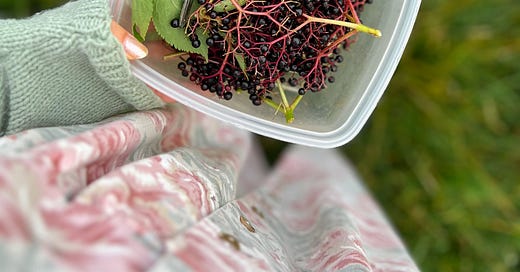Thank you so much for reading The Slow Natured Journal! This is a reader supported publication and I am so grateful to all those who have upgraded to a paid subscription. If you haven’t already, please consider upgrading to not only help me continue making content to help you live your best handmade, homegrown and slow life but also to unlock all the great content already created this year. I’d love you to join us!
Ah Elder trees. Beautiful and ancient, these trees have been popular for centuries. Giving frothy white flowers in late spring time and juicy dark purple berries on redden stems in early autumn, (both of which are edible!) there is so much you can get from an elder tree.
Many of us will have drunk an elderflower cordial. This softly fragrant drink seems to have had a resurgence in the last decade and is often the bubbly alcohol free alternative to champagne or prosecco at events. And whilst the taste and smell of elderflowers is delightful, I personally prefer the rich fruity taste of it’s berries.
Elderberries have been used for centuries as a remedy for colds and flus. Supposedly the Romans also used these berries for hair dye and I know many a natural yarn dyer who uses them to create beautiful muted berry toned yarn. Both the flowers and the berries have many health benefits due to their vitamin content which includes vitamin A and C. They also have antiviral and anti-allergy effects and have been long known as an immune booster for the inevitable cold season which will come later this year.
Harvesting & Prep
This is the perfect time to harvest elderberries. They are just becoming ripe and juicy. But you have to be quick! The birds tend to eat as many as they can at this time of year. You’ll find elderberries in hedgerows all over Britain and in parks and even on your own street. I harvested a whole bunch this year from the communal parking area on my cul-de-sac.
Elder is easy to spot. They normally have five arrow headed leaves per stem and then an umbrella of dark purple berries with red stems. Never eat anything you’re unsure of, check online and in foraging guides to make sure you are picking the correct plant.
Take a basket or box, I quite like a large tupperware as it’s easy to clean any juice off, and a pair of good scissors or secateurs. Cut off the enter umbrella of berries. Make sure to only foraging a little from each sight and leave some for the wildlife.
Keep reading with a 7-day free trial
Subscribe to The Slow Natured Journal to keep reading this post and get 7 days of free access to the full post archives.




